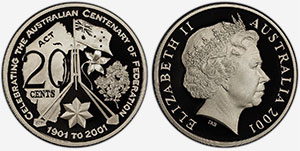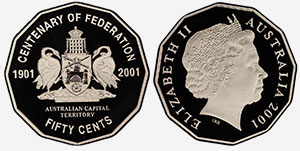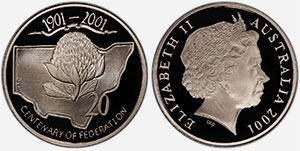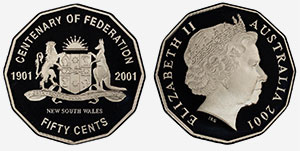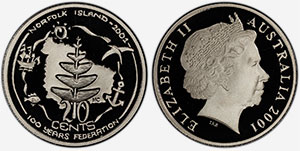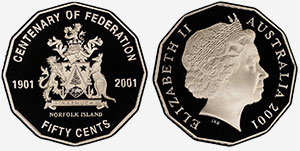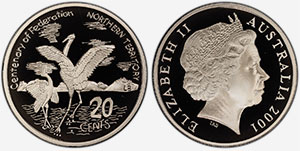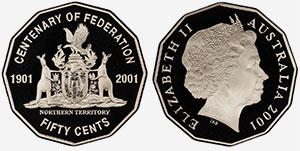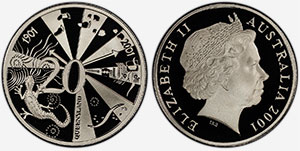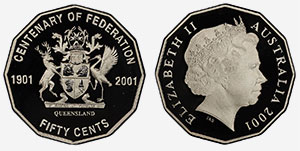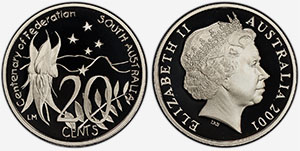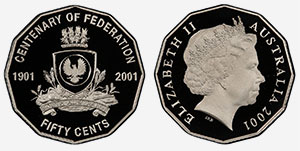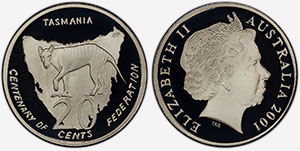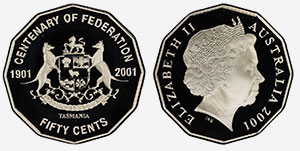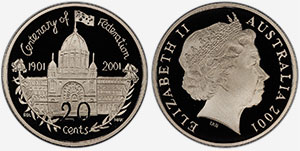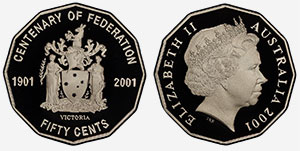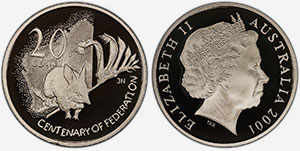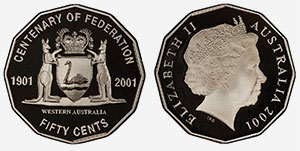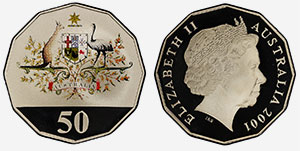20 and 50 cents 2001 - Centenary of Federation
By CAA | Wednesday, 22 November 2023
To celebrate the 100th anniversary of Federation, the Royal Australian Mint issued coins for each Australian state and territory with a reverse design represented by the coat of arms (50 cents) and other symbols and emblems. The reverse designs on the twenty cents were made by students who were the winners of the Royal Australian Mint's student design competition for their state. This was a national competition for primary and secondary school students to design a coin to represent their state or territory.
The Commonwealth of Australia Constitution Act 1900 was passed on July 5, 1900 and given Royal Assent by Queen Victoria on July 9, 1900. It was proclaimed on January 1, 1901 in Centennial Park, Sydney. Sir Edmund Barton was sworn in as the interim Prime Minister, leading an interim Federal ministry of nine members.
Six separate British self-governing colonies of Queensland, New South Wales, Victoria, Tasmania, South Australia (which also governed what is now the Northern Territory), and Western Australia agreed to unite and form the Commonwealth of Australia. The colonies of Fiji and New Zealand were originally part of this process, but they decided not to join the federation.
From 1901 the Commonwealth Government had constitutional power over currency matters and was keen to have a nationally acceptable currency.
Australian Capital Territory
20 cents
The design shows the symbols and icons of the Australian Capital Territory, the Federation Star and the flag-mast of Parliament House. The territory's floral emblem, the Royal Bluebell, and the Canberra Rose are also represented.
The royal bluebell (Wahlenbergia gloriosa) was announced as the floral emblem for the Australian Capital Territory on 26 May 1982 by the Federal Minister for the Australian Capital Territory. Following the grant of self-government for the Territory, it was formally endorsed by the Legislative Assembly as the official floral emblem for the Australian Capital Territory on 27 February 1997.
While the royal bluebell occurs only on the tops of the mountain ranges around Canberra, other native bluebells can be seen waving gently on thin stems, pushing up through the lawns, parks, pastures and roadside strips around Canberra.
The royal bluebell is native to the alpine and sub-alpine woodlands of the Australian Capital Territory, south eastern New South Wales and Victoria. It is protected in the wild and should not be picked or collected.
There are no legislative requirements surrounding use of the floral emblem.
50 cents
The Coat of Arms were granted by Royal Warrant on 8 October 1928 to the Federal Capital Commissioners and their successors. The City of Canberra was granted its Coat of Arms on 7 November 1928. The Coat of Arms is protected against unauthorised use by the City of Canberra Arms Act 1932.
The mace of the Australian Parliament, the sword of justice and the white rose are shown on the shield of Canberra's Coat of Arms, above and below the three-towered capital castle. The white rose commemorates the contribution by the Duke of York (later to become King George VI) in opening the Commonwealth Parliament in Canberra on 9 May 1927.
On a wreath above the shield, is a crowned portcullis (gate) representing Canberra's links with Westminster, the British seat of government. A gum tree is seen behind the portcullis and represents the growth of the garden city. The original Latin motto, Pro Rege Lege et Grege has been altered to For the Queen, the Law, and the People. The supporters are a pair of swans, one black and the other white, symbolising First Nations Australians and European Australians.
There is no Territory badge.
New South Wales
20 cents
The design features the New South Wales floral emblem, the Waratah, superimposed on an outline of the State.
The New South Wales waratah has been the floral emblem of New South Wales since 1962. Brilliantly coloured waratah blooms can be seen for miles. No wonder the New South Wales waratah was given the Greek botanical name of telopos, meaning seen from afar. There are 4 other waratah species in Australia, occurring from Tasmania to northern New South Wales.
The waratah flower is made up of a pincushion arrangement of small flowers, surrounded by bright red bracts, with blooms growing up to 12 centimetres wide. The flowers appear on tall bushes with stiff, long, saw tooth leaves. While the flowers are pollinated by the many native birds which perch on the blossoms to sip the nectar, waratahs are notoriously hard to cultivate.
Unfortunately, no one now knows the exact meaning of the Aboriginal name waratah, however it comes from the language of the Eora people and appears in a number of First Nations Australians Dreaming Stories across New South Wales nations.
In an Aboriginal Dreaming Story, Wamili, the great hunter, loved the nectar of the waratah. When he was struck blind by lightning, the Kwinis, tiny bush spirits, made the central pincushion flowers of the waratah more rigid so Wamili could find the bloom by touch.
You can find waratahs in the Blue Mountains, west of Sydney, and a rare breed of white waratahs can be found only in the southern highlands; you can't pick them as they are protected by the state. The waratah was adopted into the New South Wales Government logo and brand in 2009 which features prominently and consistently across government communications and within the community.
50 cents
The New South Wales state Coat of Arms was granted by King Edward VII in 1906. On the New South Wales Coat of Arms, a lion and kangaroo support the shield on which the old state badge of the colony appears. A golden fleece and sheaves of wheat symbolise the greatest achievements of New South Wales' agricultural industries of the time. The crest above the shield is of the rising sun which represents the newly rising country, and rests on a wreath of silver (white) and blue which represent the state's livery colours.
Motto on Arms
Reflecting the rising sun crest of New South Wales, the state's Latin motto is:
Orta recens quam pura nites: Newly risen how brightly you shine.
Norfolk Island
20 cents
The centrepiece of the design features the Norfolk Pine, superimposed on a map of the Island, surrounded by symbols that tell the story of Norfolk. The ship denotes the deilvery of supplies, whilst the sun, a bird and a fish symbolise the Island's natural beauty. The anchor represents the sunken navel vessel, HMS Sirius.
The Norfolk Island flag was proclaimed on 11 January 1980 and also features a green Norfolk Island pine (Araucaria heterophylla) standing between 2 vertical green bands on the flag of Norfolk Island.
50 cents
The Norfolk Island Coat of Arms was granted by Queen Elizabeth II in 1980.
The shield of Norfolk Island's Coat of Arms has 2 stars, which relate to 3 Coats of Arms: those of Captain James Cook (the Island's European discoverer in 1774), those of New South Wales and those of Australia. These shine on either side of a Norfolk Island pine. Supporters of the shield are Britain's lion and Australia's kangaroo. The lion at the top of the crest holds a cup, which is from the Coat of Arms of Fletcher Christian, the leader of a group of British mutineers and Tahitians from HMS Bounty who first settled at Pitcairn Island, a British colony several thousand kilometres eastwards in the central Pacific.
In 1856, because of overpopulation, 194 Pitcairn Islanders were moved to Norfolk Island. Their descendants still live on both islands.
Motto on Arms
Inasmuch is the islands motto. It is a reference taken from the Gospel of Matthew in the New Testament (Chapter 25:40) which has special significance for the Pitcairn Islanders: ...Inasmuch as ye have done it unto one of the least of these my bretheren, ye have done it unto me ...
Northern Territory
20 cents
The design features a pair of brolgas, performing graceful, intricate movements.
The water depicted at the base of the design represents the wetland environment that is home of the brolga, while the hills and open skies that form the background, depict the beauty of the Northern Territory landscape.
50 cents
The Coat of Arms is symbolic of the people, history and landscape of the Northern Territory. It features the floral and fauna emblems, the Sturt's desert rose, 2 red kangaroos and a wedge-tailed eagle.
The kangaroos hold a shield decorated by Aboriginal people's motifs in one hand and shells found on the Northern Territory's coastline in the other.
In the centre of the shield is an x-ray drawing of a woman as seen in rock art in Arnhem Land. The designs on either side symbolise camp sites joined by path markings of Central Australian Aboriginal peoples.
The eagle holds an Aboriginal Tjurunga stone that rests on a helmet. The helmet is a reminder of the Northern Territory's war history.
Queensland
20 cents
The design represents the progress of Queensland, using the surface of the coin as a clock.
The hour hand points to Federation (1901) and the progress in society is shown in the transformation of footsteps to shoeprints.
The minute hand indicates 2001, and is succeeded by computer chipboard denoting the futur.
50 cents
Queensland's Coat of Arms is the oldest in Australia and was granted to the colony by Queen Victoria in 1893. It was the first Coat of Arms assigned to any British possession since King Charles II granted Arms to the island of Jamaica in 1661. As of August 2012, the Queensland Coat of Arms has been used as the government's corporate logo.
The shield on the state's Coat of Arms symbolises Queensland's primary industries: a sheaf of wheat, the heads of a bull and a ram, and mining which is represented by a column of gold rising from a heap of quartz.
On the crest, the state badge (of the Royal Crown and Maltese cross) is framed by 2 stalks of sugar cane. The badge was incorporated in the Queensland Coat of Arms in 1893.
In 1977, during the Queen's Silver Jubilee year, the Coat of Arms was given a more modern appearance when Queen Elizabeth II granted the inclusion of supporting animals, the brolga and the red deer. The brolga is one of Queensland's most distinctive birds and symbolises the native population. The red deer was introduced from the royal herds near London and represents the old world.
Motto on Arms
On the Coat of Arms is Queensland's state motto, Audax at Fidelis, which means Bold but Faithful.
South Australia
20 cents
The design features Sturt's Desert Pea, the floral emblem of south Australia, the Flinders Ranges, which are the most significant elevated land masses in South Australia and the Southern Cross star constellation that has appeared on unofficial flags from the 1850's and features on the National flag today.
Sturt's desert pea was adopted by the South Australian Government on 23 November 1961 as the state's floral emblem.
Blood red, with a central blue-black blotch, Sturt's desert pea flowers in autumn in clusters of up to 8, which are held up on a short stem. It is probably the most striking of all the plants of inland Australia, thriving in arid deserts and other areas receiving less than 380 millimetres of rain a year.
Colour variations have been found from pure white to pink and purple.
The seed is hard-coated. To be planted, it should first be soaked in hot, not boiling, water to germinate, rather like wattle seeds.
50 cents
Proclaimed on 19 April 1984, the state's Coat of Arms replaces an earlier Coat of Arms conferred by King Edward VIII in 1936. The state badge, the piping shrike, appears on a shield in the centre of the Coat of Arms. The crest is of 4 sprigs of Sturt's desert pea mounted on a wreath of red, blue and gold. The Coat of Arms stands on a grassy mount, on which stands grape vines, stalks of wheat and barley, citrus fruits, 2 cog wheels and a miners pick, along with a scroll bearing the name South Australia.
Tasmania
20 cents
The design features the Thylacine or Tasmanian Tiger superimposed on a map of Tasmania.
The Thylacine was a large, carnivorous, dog-like creature with stripes.
The arrival of European settlers saw the species hunted to extinction, with the last known Thylacine dying in the Hobart Zoo in 1936.
50 cents
King George V granted Tasmania its Coat of Arms in 1917, which was later proclaimed in 1919.
The central shield in Tasmania's Coat of Arms is supported by 2 Tasmanian tigers or thylacines. These carnivorous marsupials were regularly represented in First Nations Australians rock art and Dreaming Stories. Sadly, they are now believed to have been extinct since 1936 when it was documented that the last known living thylacine died in Hobart Zoo. Unconfirmed sightings have been regularly reported in the decades since.
Within the shield are a branch of hops, a plant whose cones are used for beer-making; a sheaf of wheat (Tasmania was the breadbasket of Australia's early colonies) representing agriculture; a ram illustrating the wool industry; and apples for the then Apple Isle. A thunderbolt refers to Tasmania's hydro-electric power system.
On the crest, the red lion holds a pick and shovel to represent the state's mining industry.
Motto on Arms
Tasmania's motto is Ubertas et fidelitas: Fruitfulness and faithfulness.
Victoria
20 cents
The centrepiece of the design is Melbourne's Royal Exhibition Building, surrounded by Victoria's floral emblem, the Common Heath.
The Royal Exhibition Building was completed in 1880 and hosted the opening of the first Parliament of the Commonwealth on 9 Mai 1901.
Today, it remains one of the world's oldest and largest pavilions.
50 cents
From 1870, the 5 stars of the Southern Cross appeared on Victoria's colonial badge. In 1877, a Royal Crown was added to the badge to top the Southern Cross to align the Coat of Arms badge with the Victorian flag badge. In June 1910, Victoria was granted its Coat of Arms by Royal Warrant.
The shield is blue with the 5 stars of the Southern Cross. Its supporters are 2 female figures named Peace and Prosperity, the state's motto.
The state's floral emblem, common pink heath, was added to the Coat of Arms in 1958 and grows from a grassy mound under the shield. Above the shield is a wreath of silver and blue, and the torso of a kangaroo holding the Royal Crown. The design of the Crown was changed from the Imperial Crown to St Edward's Crown in 1973.
The colour references are:
- Blue: PANTONE® 541, and
- Silver: PANTONE® 877.
These are also the state colours.
Motto on Arms
Peace and Prosperity.
On the Victorian Coat of Arms, Prosperity holds a horn of plenty (cornucopia) to symbolise rich harvests and she wears a circlet of golden cereal. Peace holds a symbol of peace, the olive branch.
Western Australia
20 cents
The red and green kangaroo paw was proclaimed the state's floral emblem in November 1960 and was incorporated into the Coat of Arms of Western Australia on 17 March 1969.
Western Australia's floral emblem grows naturally only in Western Australia. The red and green kangaroo paw is striking for its brilliant red and green flowers that appear in spring and summer in fan-like clusters at the end of red felted stems. The sturdy high stems provide a ready-made perch for honey-eaters and wattle-birds, which are often seen clinging precariously to the stem, drinking nectar from each of the flowers in turn and helping in pollination.
The red and green kangaroo paw is the best known and most famous of all the kangaroo paws. The plants flower from July to November and are usually found in many areas of remnant bushland near Perth and is common in the sandy coastal plains of the south-west of the state, ranging from Shark Bay in the north, to Scott River and Mount Barker in the south.
The coin also features the Bilby, one of Australia's endangered species, with its decline in population being attributed to rabbits and other introduced species.
50 cents
The state Coat of Arms was granted by Queen Elizabeth II by Royal Warrant on 17 March 1969. Use of the Coat of Arms is protected under the Armorial Bearings Protection Act 1979.
The central part of the Western Australian Coat of Arms is a silver shield showing a black swan floating on a blue base representing water. It is supported by 2 red kangaroos, each holding a boomerang. The crest on the Coat of Arms is a Royal Crown on a gold and black wreath between 2 kangaroo paw flowers.
Commonwealth Coat of Arms
Another circulating 50-cent coin was also made with the second Commonwealth Coat of Arms. In proof sets, this coin was colourized.
Australia's first Commonwealth Coat of Arms was granted by King Edward VII in 1908. This showed the kangaroo and emu supporting the shield and standing on a grassy mound. Australia's second Coat of Arms was granted in 1912 by King George V in a document called a Royal Warrant. This made changes to the first Coat of Arms to include the symbols of the states.
Symbols of Australia's 6 states are woven together into the Coat of Arms with a kangaroo and an emu standing on either side of the central shield.
The central shield features the black swan of Western Australia, the lion and stars of New South Wales, Victoria's Southern Cross, the Maltese Cross and Crown of Queensland, the walking lion of Tasmania and the piping shrike of South Australia.
The border of the shield symbolises Federation, which was the union of the states into the Commonwealth of Australia in 1901.
The Commonwealth Star appears in gold at the top of the Coat of Arms and also appears in white on the national flag. A wreath of gold and blue appears under the Commonwealth Star. These colours are known as the livery colours of the Coat of Arms.
The supporters of the shield (the native animals chosen by Australians to hold the shield) are 2 of our best known wildlife symbols, the kangaroo and the emu. Though chosen because they are familiar and uniquely Australian creatures found in almost all states and territories, some say these animals were chosen because of the common belief that neither can move backwards easily, reflecting a nation's intent on moving forward.
Australia's floral emblem, the golden wattle, frames the Coat of Arms, with a scroll reading Australia.

